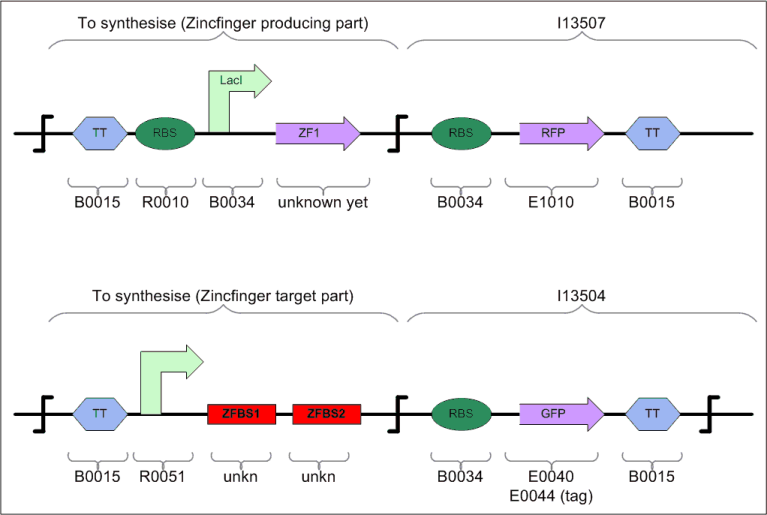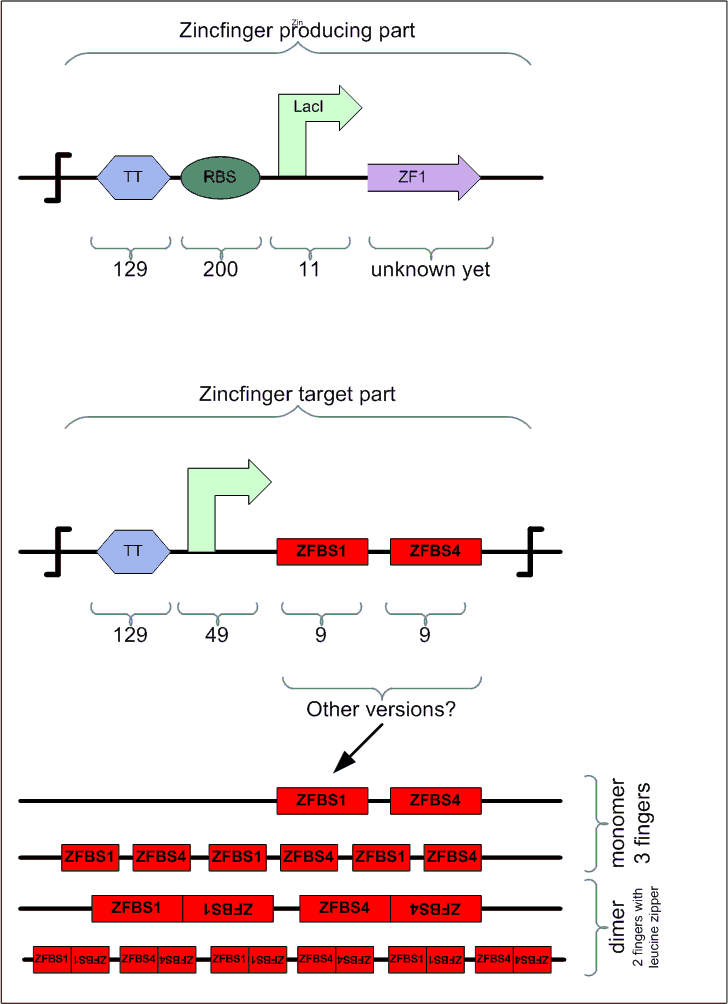4-State Device
From 2006.igem.org
Back to the ETH Zurich main page.
Contents |
Organisation
Group Members
- Alexander Roth(coordinator) Urs A. Müller Simon Barkow Tamara Ulrich Robin Künzler
Meetings
2005.08.17, Wednesday, 15:30 @ Alex' bureau (CAB F62) Summary 2005.08.18, Thursday, 13:15 @ Alex' bureau (CAB F62) 2005.08.22, Monday, 13:45 @ Alex' bureau (CAB F62) Summary 050822 2005.08.25, Thursday 15:30 @ Alex' bureau (CAB F62) 2005.08.29, Monday 14:00 @ Alex' bureau (CAB F62) 2005.08.30, Tuesday 16:00 @ Alex' bureau (CAB F62) 2005.09.06, Tuesday 08:00 @ Alex' bureau (CAB F62)
Description of NOR module
This module behaves like a NOR gate. It has two inputs and one output. The output is high only when neither input 1 nor input 2 is high.
NOR-module Schematic
Below a preliminary parts-view of the module with PoPS interfaces (i/o).
---------------------------------
| ------------\ |
PoPS_in1 ---->| | Repressor1 | -------- |
| ------------/ | |
| = |
| --------|------> PoPS_out
| = |
| ------------\ | |
PoPS_in2 ---->| | Repressor2 | -------- |
| ------------/ |
---------------------------------
Design
Zinc Fingers
A zinc finger [http://en.wikipedia.org/wiki/Zinc_finger] is a protein domain that binds to double stranded DNA. The idea is to use a zinc finger protein (ZFP) as a repressor by putting a ZFP binding site upstream of the coding region and thereby preventing RNA polymerase to transcribe the gene. Each Zinc finger domain binds to three base pairs and many domain-DNA interaction have been described, therefore making it possible to to construct artificial transcription factors by combining domains.
Zinc Finger Proteins
In total for the counter we will need four ZFPs. We have two different designs of the ZFPs.
1. Three domains to recognize nine base pairs.
2. two zinc finger domains and a leucine zipper domain. The leucine zipper will be cause the protein to home-dimerize and hence it will recognize 12 base pairs.
Zinc Finger Protein Binding Sites
Since we are going to synthesize parts of out module, we have the possibility to design our own ZFP binding sites, as well as our ZFPs. We have to different candidates for placing the binding sites.
1. Binding sites in the promotor. This would prevent the polymerase from binding to the promotor.
2. Binding sites directly after the start of transcription and before the ribosome binding site. This alternative is quite attractive, since it would allow for a high degree of modularity. In theory the ZFP would act as an extra "roadblock-operator" and any promotor could be used in front of the protein.
Tester for Zinc Finger
System Variants
Currently, we have two systems, and we hope that at least one of them is going to work.
The first system, cryptically labelled "Min+RepressionDomain" below, consists of 4 proteins and 4 operator regions. Each protein has four domains: a) 3 zink fingers that bind to specific sites on the helical DNA, and b) one repression domain. We call the whole system (i.e. a) and b)) "Zinc Hand" to distinguish it clearly from the individual zinc finger domains.
In the second system, each protein has also 4 domains: 2 zink fingers, 1 leucine zipper and 1 repression domain.
The operator regions in both systems are made of 2 binding regions, each of which lets a specific Zinc Hand bind to it and thus each consisting of the corresponding 3 codons that match the 3 zinc fingers in that Zinc Hand. The operator regions (i.e. the "roadblocks" that will prevent the binding of the RNApolymerase) form a BioBrick that should be inserted between the promoter region and the ribosome binding site in order to keep the design modular.
Note that in both case, it is still under discussion as whether the repression domain should really be included or not. If it turns out that repression has been used in all the literature we can find, then we would be better off to play safe and include them.
| Type | Size (bp) | . | . | . | . | TOTAL SIZE (bp) | |
|---|---|---|---|---|---|---|---|
| Min+RepressionDomain | Repressor | 400 | ZHR1 | ZHR2 | ZHR3 | ZHR4 | 1600 |
| . | Operator +1/+10 | 30 | ZHO1.1 | ZHO2.1 | ZHO3.1 | ZHO4.1 | 120 |
| LZ+RepressionDomain | Repressor | 400 | ZHR5 | ZHR6 | ZHR7 | ZHR8 | 1600 |
| . | Operator +1/+10 | 30 | ZHO5 | ZHO6 | ZHO7 | ZHO8 | 120 |
| TOTAL | . | . | . | . | . | . | 3440 |
ZHR stands for Zink Hands Regulatory proteins, and ZHO for Zink Hands Operators. The +1/+10 indication reflects the starting position on the DNA of the operators.
We considered adding a variant with degradation tag, since the system might be slow otherwise. However, due to the fact that we have limited resources - in terms of money, manpower, and time - and the fact that the degradation is decoupled and it will be clearly visible if the system turns out to be too slow, we decided against it for now.
Assembly
- Cut each system into BioBricks Pieces using different restriction enzymes.
- Assemble in parallel for each genes 1-4 in two variants: promoter+operator, rbs+gene
- Assemble the two constructs
- ...
(please complete the above and add the test/debugging steps)
References
Kim & Wang (??)
Park et al. 2005 (Activation of transcription)
Chou et al. 1998
Beerli00 (Linker)
Segal99 ("GNN-paper")
Dreier01 ("ANN-paper")
Dreier05 ("CNN-paper")
Yang95 (Kinetics!!)
Klug05 (Minireview)
Newman03 ("Leucine Zippers")

